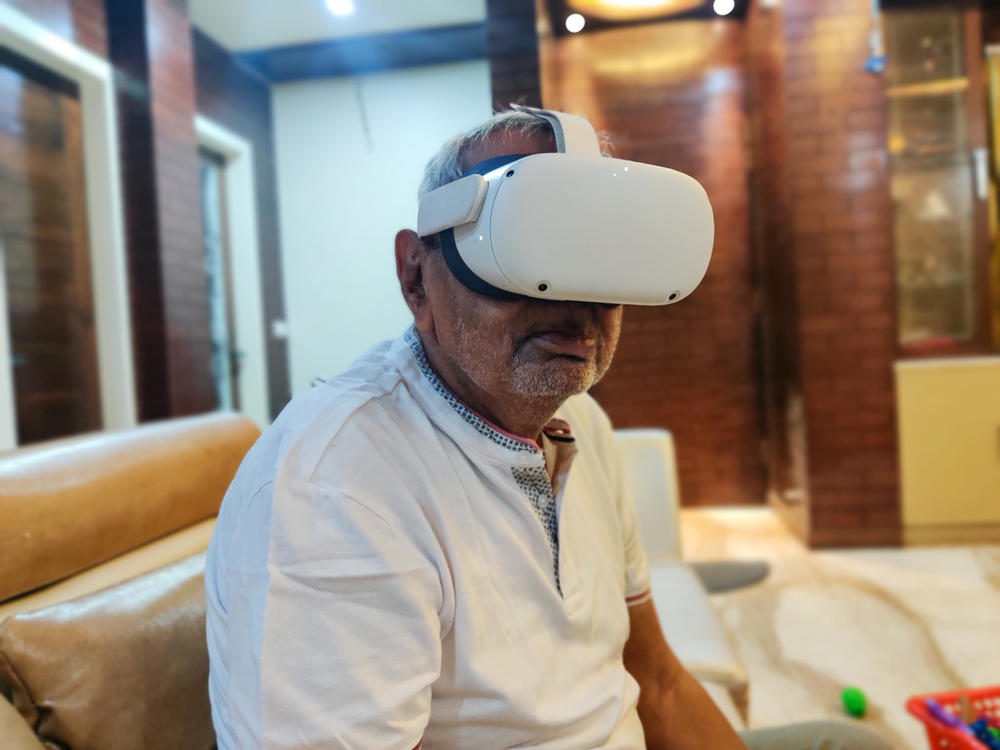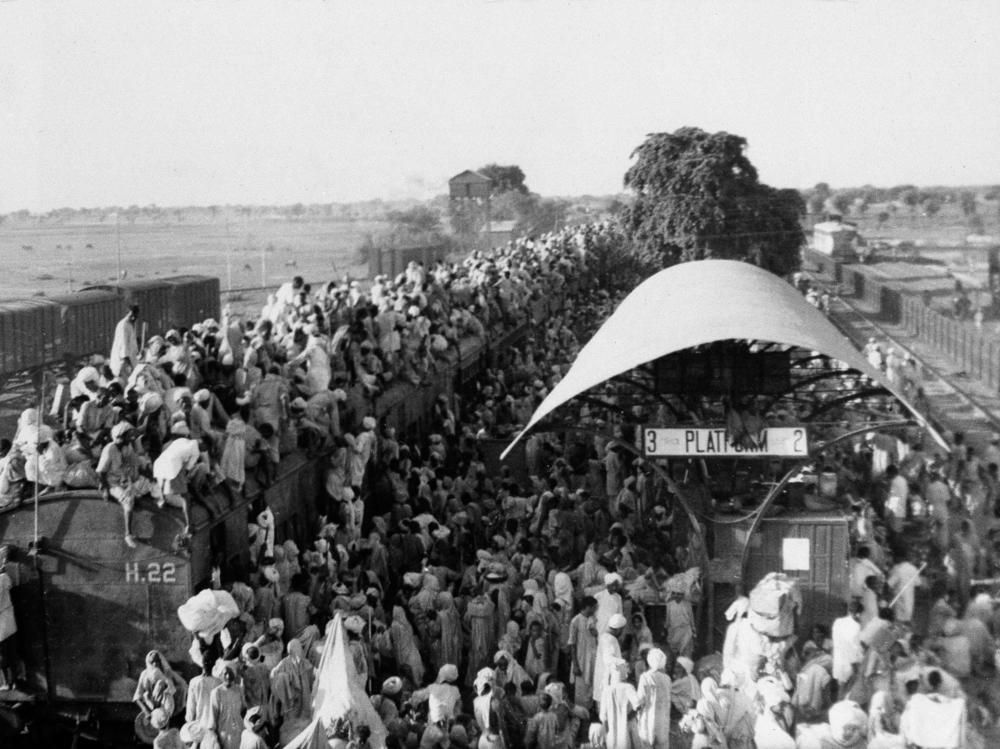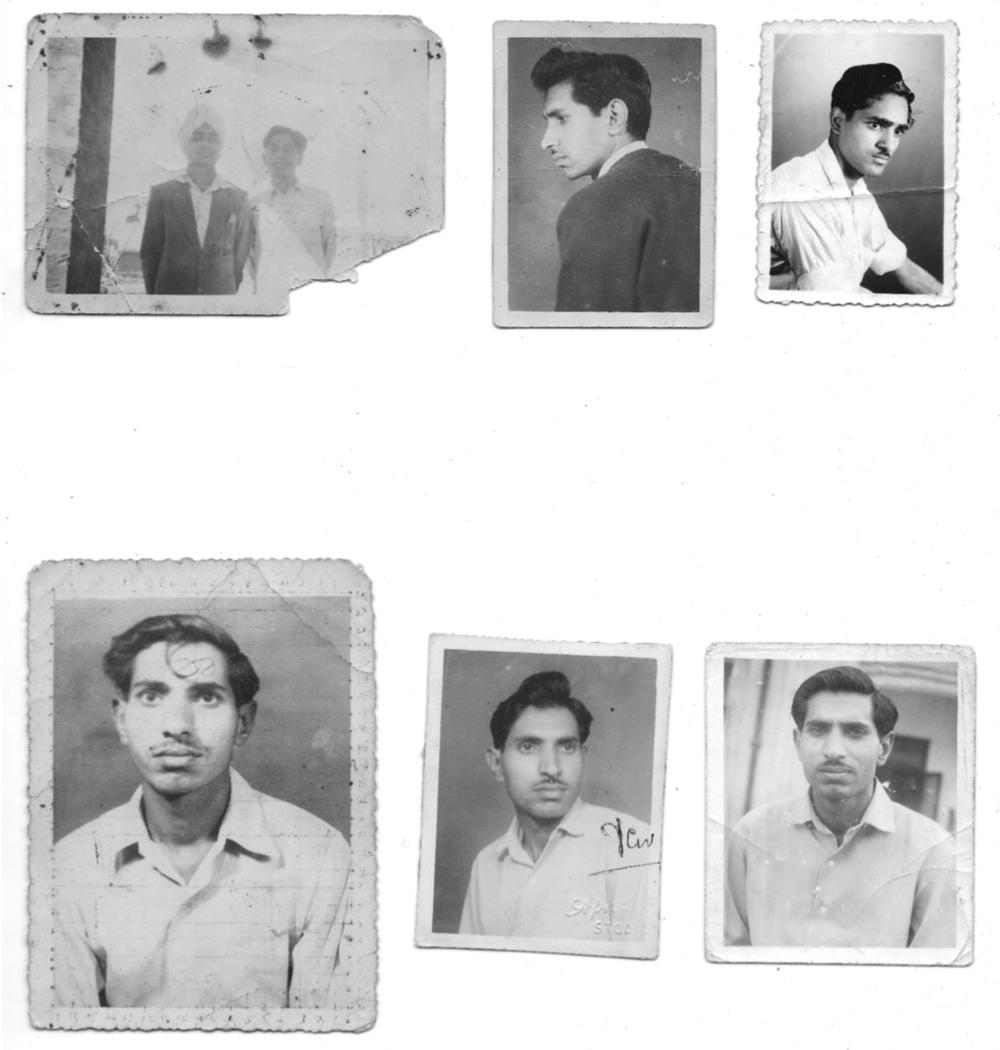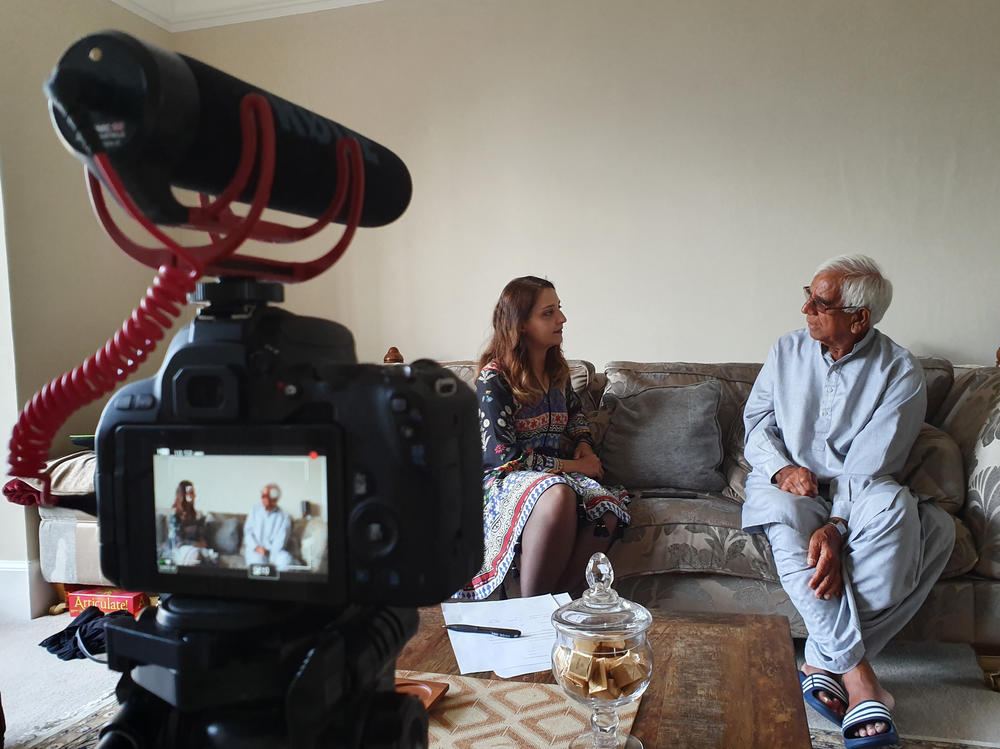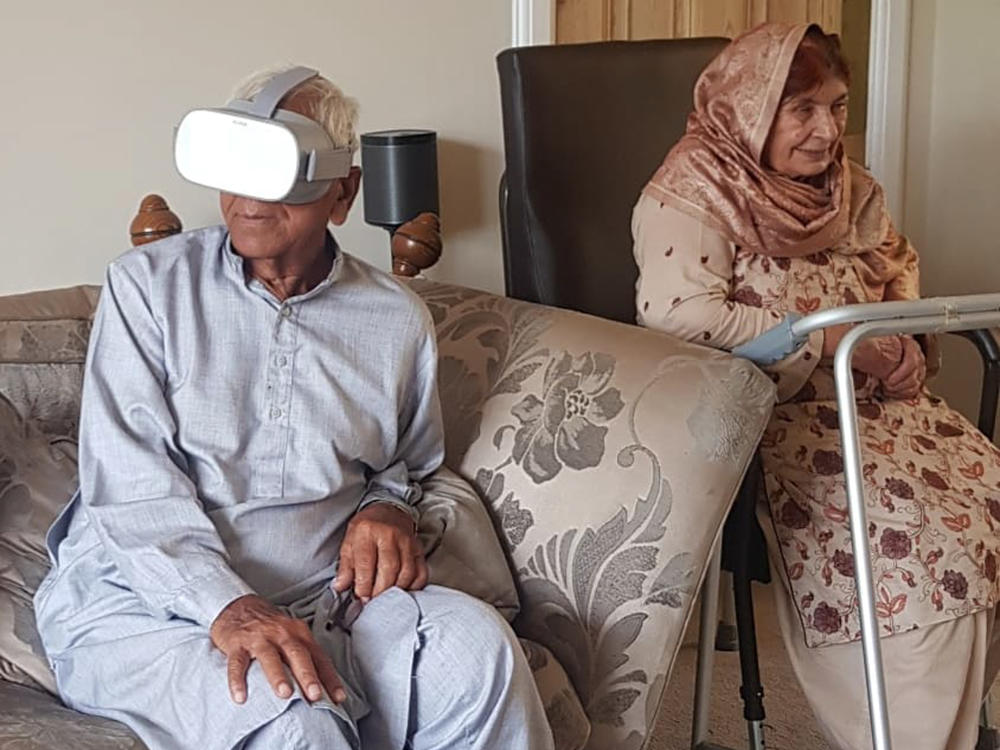Section Branding
Header Content
75 years after India's violent Partition, survivors can cross the border — virtually
Primary Content
NEW DELHI — First comes the melancholy twang of a South Asian sitar, plucking a ballad about nostalgia for childhood. Then the name of a faraway yet familiar place appears on a black screen, in Hindi. Suddenly the screen bursts into 3-D light, revealing a dusty street corner — one that Ishar Das Arora hasn't seen in 75 years.
"It's as beautiful as I remembered," he murmurs.
Das peers deeper into what looks like a bulky kaleidoscope strapped to his face, with stereo speakers over each ear. Inside, he sees auto rickshaws where there were once donkey carts. He spots an old mosque with the same pristine white dome he remembers, ringed with arches. He's surprised to see new concrete houses mixed in with older mud-brick ones.
Hot-pink bougainvillea spills over a fence. Someone has decorated a nearby tree with garlands for a wedding.
"My school is still there!" Das exclaims. "And the hills where we used to yell as children, and the last word would come back to us in an echo."
Das, 83, is sitting on his sofa in India's capital. But he feels like he's been transported back to his birthplace in what is now Pakistan — courtesy of a virtual reality headset. It plays a 3-D video recorded recently in his home village of Bela — which he hasn't visited in person since he was a child.
It's part of Project Dastaan ("story" in several South Asian languages), a documentary project that delivers immersive video experiences to survivors of the 1947 Partition of British-ruled India into independent India and Pakistan.
A VR project for Partition survivors who can't go back
Aug. 14-15 marks 75 years since colonial India was carved into two free nations. Millions of Hindus crossed the subcontinent to reach independent India, while millions of Muslims headed the other way, to the new country of Pakistan, created as a homeland for them.
It was one of the biggest migrations in human history, and one of the bloodiest. Hundreds of thousands of people were killed, and tens of millions displaced.
Today, relations between India and Pakistan remain fraught — enemies at war in the worst of times; uneasy neighbors at best. Travel between the two is difficult. Many Partition survivors have been unable to visit their birthplaces. So Project Dastaan's roughly two dozen volunteers and filmmakers, based in India, Pakistan and the U.K., travel for them, recording 3-D videos and 360-degree vistas of the hometowns they left behind.
The project was founded in 2018 by friends studying at Oxford University: an Australian man of Indian descent, a Pakistani woman and a Briton who grew up partly in India. Their aim, they say, is not for survivors to relive the horrors of Partition. In fact, they underwent trauma sensitivity training to ensure they interacted with survivors ethically. Instead, they want to help unearth and document survivors' childhood memories from before Partition — and show them what their birthplaces look like now, 75 years on.
This is one of many Partition-related projects — videos, oral history archives, Instagram pages — documenting this period of South Asian history, and even more have sprung up in advance of this summer's anniversary.
"The generation that witnessed Partition is in its twilight years, so there's an urgency to record what they remember," says Aanchal Malhotra, a New Delhi-based oral historian who has written several books about Partition.
Malhotra says she's been inundated with calls in recent months from "citizen historians" — from various history projects but also ordinary citizens — asking her to connect them with survivors. But "the first thing they think about, when they think of Partition, is the violence — not the severed relationships or the lost homeland," Malhotra says.
She says she's been impressed, in contrast, by Project Dastaan's efforts to "separate human relationships from the geopolitics of the land."
The project has received support from arts foundations, journalism nonprofits and the National Geographic Society. Some of its short documentaries are being screened this summer in India, Pakistan, the U.S. and the U.K.
One of the founders is Ishar Das Arora's grandson.
As a village burned, a Muslim neighbor offered Hindus refuge
Das' last glimpse of his birthplace was traumatic: He was 8 years old, and his village was on fire.
He was born in 1939 in western Punjab, now part of Pakistan. Hindu families like his were minorities in a mostly Muslim area. In 1947, the Das family, like many others, came under attack.
They were forced to flee their hometown of Bela, surrounded by green hills, and head for the Indian border with only what they could carry: food and supplies from a shop the family ran, and important documents, including Das' and his brother's elementary school certificates.
"As we fled, I saw our village go up in flames," Das recalls. "All the Hindu houses were set on fire."
Das, his parents and his brother hid in a cattle shed. He remembers the hay, and how his father had a cough. They worried he wouldn't be able to stifle it, and that the sound would give away their hiding place.
But a kind Muslim neighbor — Bela's village chief — protected them.
"He hid us in another building and sat atop the roof to fend off mobs of attackers," Das explains.
They survived the night. The next day, they headed east — and soon crossed into India.
That was the last Das ever saw of Bela. Seventy-five years later, those elementary school certificates are all he has left from their life there.
75 years later, memories flood back
Das' family spent time in a refugee camp near the Indian border city of Amritsar, and later moved to New Delhi. He became a civil engineer. He got married, had children and grandchildren.
"Several years ago, we actually went to a wedding in Amritsar, and that's when he started talking, that there was a camp near there," says Das' grandson Sparsh Ahuja, 24, one of Project Dastaan's founders. "My grandfather is the only one in the family who can write in Urdu, and I'd always wondered, 'How come you can do that?'"
At that family wedding, Das' memories flooded back and he inundated his grandson with stories about this beautiful village called Bela.
That gave Ahuja an idea. He has Australian citizenship, so he could travel to Pakistan more easily than his grandfather, who holds an Indian passport. While studying in the U.K., Ahuja had made Pakistani friends — with whom he hatched a plan.
"It's difficult, for example, for me to visit India. It's hard for [Indians] to visit Pakistan," says Saadia Gardezi, one of Ahuja's Pakistani friends. "So how can we collaborate to kind of show former refugees their ancestral homes again?"
Together with a third friend, Sam Dalrymple — who grew up partly in India as the son of renowned historian William Dalrymple — Ahuja and Gardezi founded Project Dastaan. They were inspired by the experiences of Partition survivors like Ahuja's grandfather, but they also see their work as a public service.
"When you've grown up in India or Pakistan, you have a very one-sided official history. Projects like ours basically help fill the gaps," Gardezi says. "We often joke that if you put together the national curriculums of India and Pakistan, maybe we can have kind of a story of what actually happened and what our actual histories are."
So they applied for grant money, got sensitivity training and pulled out a map of the subcontinent.
A grandson goes in search of his ancestral village
Das' hometown of Bela is so small, it's not on Google Maps.
"The road stopped. The cab driver was getting nervous. He was like, 'Let's get out of here, where are you taking me?'" Ahuja recalls of his journey last year to Bela.
He'd flown to Pakistan's capital Islamabad on his Australian passport. His cofounder Dalrymple came along. They packed a GoPro video camera and a handwritten map Ahuja's grandfather had sketched on a page of his journal, based on his memory of the layout of the village.
Somehow, they found Bela.
"When we got to the town, it was just a little hamlet — a collection of a few mud houses, and a few concrete houses now as well. It was completely empty," Ahuja recalls. "I'm standing in front of this mosque like, 'How am I going to find anything here?'"
So he approached a woman on the street and explained his predicament. He wanted to find the family of the village chief — the man who had sat atop a roof guarding his grandfather, protecting him all those years earlier.
"And she's like, 'I don't know if it's the same guy, but that's his house over there,'" Ahuja says.
He knocked on the door. A man answered. Ahuja told his story again, and the man replied: "That was my grandfather, who saved yours."
Within hours, word got around and the village erupted into celebrations. Neighbors invited Ahuja to a wedding. This is your village too now, they said. They took him on a tour, which Ahuja filmed: the site of old Hindu homes, the white-domed mosque with arches, the old elementary school where his grandfather got his certificate.
Villagers lined up to record video greetings for Ahuja's grandfather.
"Then I mentioned the story about the hill that echoed, and the great-grandson [of the village chief] was like, 'I know where that hill is! We call it the speaking hill,'" Ahuja recalls.
Village residents took him there, and Ahuja filmed the green hills. Standing on the edge of Bela, he called out into the distance, listening for the echo of his voice — just as his grandfather had done more than 75 years earlier.
Video screenings in India, Pakistan, the U.S. and UK
Back in New Delhi, Ahuja edited his video from the trip into a 7-minute, 3-D immersion experience, which he presented to his grandfather. He set the footage to music — "Ye daulat bhi lelo" by Jagjit Singh — a favorite song about nostalgia, which Das likes to sing.
Das has since watched the video several times, disappearing back into his boyhood for 7 minutes at a time. When NPR met him, he hummed along with the music and smiled while watching video of the village chief's descendants.
"He often doesn't show it in the moment, but then I'll get a text message at like one o'clock in the morning saying, 'I feel so emotional, thank you so much,'" Ahuja says.
Ahuja, Gardezi and Dalrymple have produced dozens of videos like this. So far, they've reconnected 30 Partition witnesses with their ancestral communities in India, Pakistan and Bangladesh. They've tracked down childhood friends and located old houses and schools.
In the case of Bela, the village hasn't changed much. But that's not always the case.
"You go in search of a small building that was mud-brick, and everything is now super-modern — multistory apartments and glass-fronted shops — and the only thing that remains is an old well or a tree," Dalrymple explains.
The audience for this project is Partition survivors and their families — but also the societies they live in.
"Just the simple fact that [my grandfather] was saved by Muslims! He was attacked by Muslims and also saved by Muslims," Ahuja notes. "That's not something that fits neatly into the boxes of either Indian or Pakistani national history."
NPR producer Raksha Kumar contributed to this report from New Delhi.
Copyright 2022 NPR. To see more, visit https://www.npr.org.
